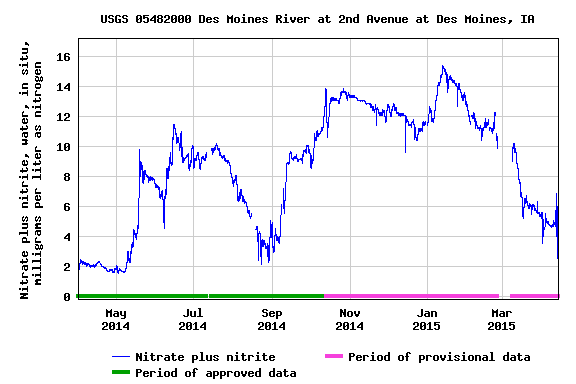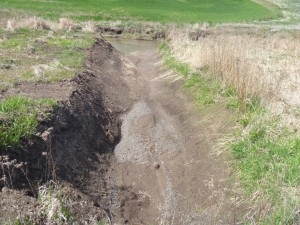Recently, I've heard a number of radio stories about nitrate levels in Iowa's Des Moines River. I began to wonder how they might compare to nitrate levels in our watershed and I thought I would do some investigating. Back in Iowa, the city of Des Moines sued a number of counties upstream due to the high levels of fertilizer in the form of nitrate that is contaminating their drinking water supply and forcing costly removal. My questions are just how high are nitrate levels in the Des Moines River, how do they compare with local levels of nitrate in Hangman Creek, and what are the possible implications for our watershed?
Nitrate is often applied to farmland as fertilizer. It comes from other sources as well, such as septic systems and wastewater treatment plants, but most nitrate in surface waters comes from unfiltered runoff from fertilized fields. In some cases, improper management of dairy manure can cause nitrate contamination in ground water. Drinking water with high levels of nitrate can cause blue baby syndrome and impact human, particularly infant, health.
How high are the levels of nitrates in the Des Moines River? They are certainly above the EPA drinking water limit of 10 mg/L. In fact, they reach up to 16 mg/L, exceeding the safe drinking water limit for many months (see figure below). It is clear that the Des Moines River is very contaminated with nitrates.
Recently I have been testing Hangman Creek water for nitrate. The results of this testing reveal that Hangman Creek contains high levels of nitrates as well, at least relative to other Washington creeks and streams, but not as high as levels in the Des Moines River. The graph below show nitrates in Hangman Creek compared to the Little Spokane River. Hangman Creek contains 3-4 times more nitrates than the Little Spokane River and some of the highest in the state, according to Ecology data.
Looking at the Hangman watershed, this isn’t very surprising. The watershed is roughly 50% agricultural and very little is being done to restrict the flow of surface waters and the associated nutrients to Hangman Creek. In fact, surface waters are often intentionally channeled directly to Hangman Creek (see picture below)! Sometimes this practice is technically legal, sometimes not, but it always comes at a high cost to water quality and fresh water ecosystems. Although nitrogen isn’t usually the limiting nutrient in most freshwater ecosystems, it can affect sensitive freshwater ecosystems.
The Des Moines River, Iowa, contains very high and unhealthy levels of nitrate. Hangman Creek does not reach these levels, but it does contain some of the highest nitrate levels in the state. The intensive farming practices in the area, including ditching surface waters directly to the creek, allow nitrogenous fertilizers to runoff into our rivers and lakes. This concerns us a great deal.
The Spokane Riverkeeper routinely monitors water quality, including nitrates, in Hangman Creek. Our preliminary data agree with Ecology data and show that Hangman Creek contains high levels of nitrates as it exits the Palouse. More on these data later...



